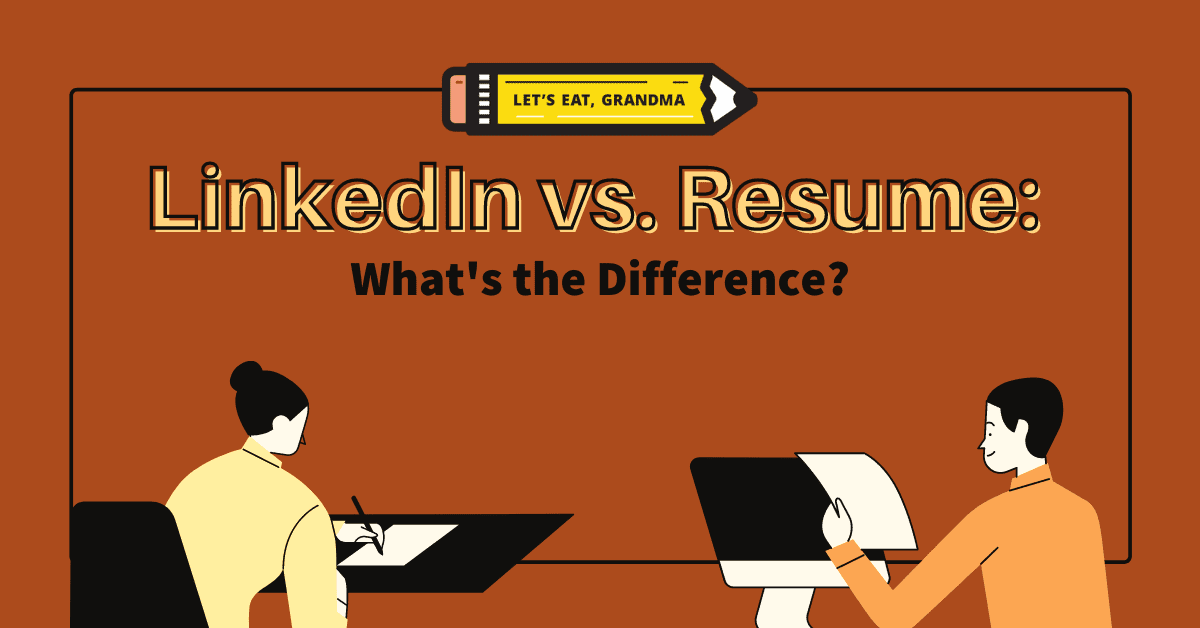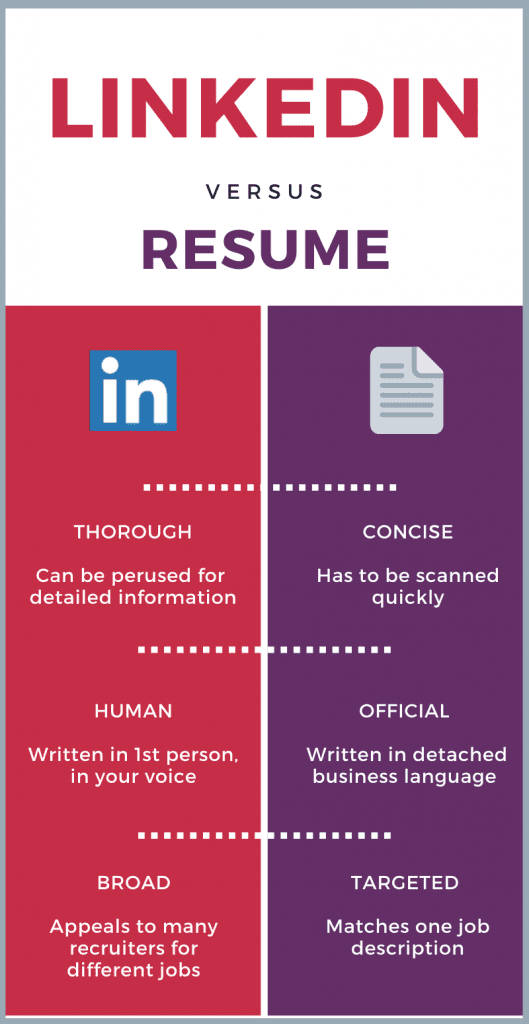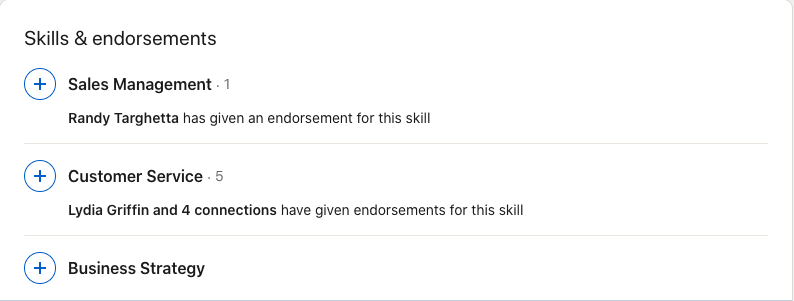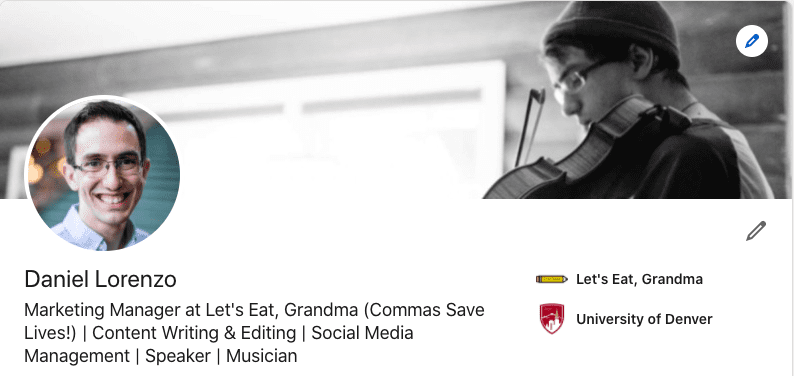Should My LinkedIn Be Different From My Resume?

LinkedIn vs. resume: is there a difference? Yes — your LinkedIn profile should NOT look exactly like your resume. Learn these three key differences to optimize your profile and land more job offers.
By: Daniel Lorenzo | Marketing Manager for Let’s Eat, Grandma
Psst. Hey! Want to hear a secret?
People are looking at your LinkedIn profile. Seriously.
You might think, like I used to, that LinkedIn is something that only your college career center and your sales-y colleagues said you should have, but only your dad actually uses.
But the times, they are a changin’. The new reality is that LinkedIn is a vital recruiting and job searching tool. Over 20,000 companies in the U.S. use it to recruit new talent. (Other estimates say that 87 – 95% of recruiters use it to find candidates.)
Ready for more job search help?
Sign up for a free Senior Writer Resume Critique to see what's holding you back from landing interviews. One of our top professional resume writers will give you personalized feedback on the top 3 items you can improve based on our expert practices!
Consider this combined with the fact that 70-80% of jobs are filled through networking, and there’s actually a good chance that you’ll get offered your next job via LinkedIn — if you have a great profile.
You Need a Great LinkedIn Profile
So, you should work on your LinkedIn profile just as hard as your resume and cover letter; it’s just as important for securing a job!
However, this does NOT mean you should simply copy and paste your resume into your LinkedIn profile. You might have heard LinkedIn called your “digital resume”. That’s… almost true, but not quite.
While it may list your professional experience like your resume, LinkedIn serves a different purpose — it’s a living, breathing networking tool. Your profile is not a document with a few key accomplishments that you submit directly to a job to be reviewed in less than 30 seconds, like your resume. It’s a versatile webpage that is meant for connecting to others. It works for you 24/7 and should be primarily used to both get the attention of professional contacts and reach out to them.
Because of this, your LinkedIn profile has some unique features that are designed to make it complement your resume. Learn and implement these three differences, and your profile will make you shine among your competition for the jobs you want.
LinkedIn vs. Resume: The Key Difference
A great LinkedIn profile is more thorough and more human than a resume. 
It should be more full because it offers more space and more time for reading. Unlike in a rapid-fire initial resume scan, recruiters and other connections can click around it to see what they’d like.
It should feel more human because it can do more than just show off your accomplishments for the one job it’s tailored to; it can give a full picture of you as a person in a way that your resume can’t.
This is the major, overarching principle of how your LinkedIn is different from your resume. It’s at the core of the following three key changes that you should make:
1. Expanded Summary Section, Professional Experiences, and Skills
Your summary section should be only a few short, vital sentences on your resume. But on your LinkedIn profile, your summary (now known as the “About” section) is much different. At a whopping 2,600 characters, your About section is the centerpiece of your profile. Think of it almost like an expanded, superpowered cover letter.
The About section is the best place for you to highlight your biggest career wins, integrate keywords that make you more visible to recruiters, show off your communication skills, and convey your personality & passion to recruiters. Why are you seeking a job in this field? What makes you great at it, and what makes you excited about your work? Include all of this in your About section.
You should also write this section in the first person, unlike on your resume. (That’s part of the “more human” piece.) Remember, recruiters want to hire real people, not just lists of duties, and your LinkedIn is a networking tool between you and other real people. So, like your cover letter, your About section is a prime place to show off your unique personality and voice.
Plus, don’t worry too much about going on too long. You don’t want to ramble or be wordy, but you have a little more breathing room with length than on your resume. Here, your readers can always click “See more.”
(Get more advice on writing a great About section with this blog.)
By the same token, you shouldn’t just copy and paste your bullet points from your resume for each professional experience you list on your LinkedIn profile. It’s so tempting, but this approach doesn’t make the most of your profile. Instead, make your descriptions of your professional experiences broader than on your resume.
Your resume needs to be carefully tailored and targeted for each job. It also needs to be short. That means you might eliminate, reorder, or reword some bullets from your professional experiences from one version of your resume to another, depending on what skills each job emphasizes.
You only have one LinkedIn profile, though, and recruiters from many different companies for several job titles that you’re interested in will all see it. So, while you may leave certain details off your resume depending on the specific job you’re applying to, your profile can include all of them.
While they should still be targeted towards the industry and types of jobs you’re applying to, the professional experiences on your LinkedIn profile can appeal to a broader group of people.
For example, if you’re in marketing, you’ll have different bullet points for the same job when you’re applying for a Social Media Manager position than when you’re applying for a Content Writer job. On LinkedIn, you can include them all!
Just like your About section, write these experiences in the first person when applicable, and remember that your readers can click “See more.”
 But wait, there’s more! You can expand your skills section on your profile as well. LinkedIn offers room for 50 skills on your profile, so you should fill it up as best you can with relevant skills. These are keywords that can help prioritize your profile in recruiters’ searches. (Don’t overload it haphazardly though — only include skills that are relevant and that you could really own up to in an interview.)
But wait, there’s more! You can expand your skills section on your profile as well. LinkedIn offers room for 50 skills on your profile, so you should fill it up as best you can with relevant skills. These are keywords that can help prioritize your profile in recruiters’ searches. (Don’t overload it haphazardly though — only include skills that are relevant and that you could really own up to in an interview.)
Be sure to handpick your top three skills, too; this section defaults to your most endorsed skills, which may not be the top three that you want to show off. For example, if you had a past career in engineering but want to shift into content writing, you’ll want those writing skills mentioned first, even if your less-relevant engineering skills are highly endorsed.
2. More Supplemental Information
You know all those things you’d love to include on your resume but don’t have space for? Put them on your LinkedIn profile!
Since your resume’s job is to briefly give a snapshot of your most relevant accomplishments for the job at hand, there are several things you should only include sparingly if at all. Unless they’re directly relevant to the job and you have the space, you need to be prepared to cut down on your:
- Volunteer Experience
- Hobbies and Interests
- Non-vital Licenses and Certifications
- Presentations and Papers (that’s more for a CV, anyway)
But while these might be on the chopping block for your resume, there’s plenty of room for them on your LinkedIn profile. (Still stay cautious with those irrelevant hobbies and interests, though.)
Again, since your LinkedIn is a website instead of a static paper document, recruiters can peruse everything on it and focus on what they’re most interested in. It has dedicated spaces for supplemental info like volunteering, academic projects, and honors, so you can include all of them.
What’s more, these supplemental elements are actually valuable as connective tissue on your LinkedIn profile. Remember, LinkedIn is an inherently social platform and your profile is a networking tool. Every piece of supplemental info you include is another chance for an easy connection.
A recruiter may volunteer for the same organization you do, follow the same thought leader, or share the same passions. That will increase your human appeal, and thus increase your chances of making a meaningful connection that will lead to a job.
Finally, the most important supplemental piece to add to your profile is recommendations. Testimonials from others on your resume are optional and typically only advised for upper-level management. On LinkedIn, they’re essential for every profile.
Your profile’s “Recommendations” section is prime real estate for social proof of your qualifications. As LinkedIn is a connection tool, it helps you if a potential connection sees that several people vouch for your greatness. It’s basically unlimited space for other people to brag about you!
Start getting recommendations for your profile as soon as possible. These can come from current and former colleagues, bosses, partners, clients, or mentors. The best way to get one from someone is usually to write one for them, then ask them to reciprocate.
3. Mandatory Profile and Cover Photo
If you didn’t already know, you should not include a photo on your resume. It’s not only a waste of space with the potential to mess with Applicant Tracking Systems, but it can be a discrimination trigger in the initial review of your resume. You have precious little space on your resume, so you should use it to focus on your accomplishments.
However, as emphatically as we tell you not to have one on your resume, we’ll also tell you that you need to have a photo on your LinkedIn profile — two of them, in fact.
A profile picture automatically increases your credibility on LinkedIn. (Remember, it’s more like a business card than your resume.) Your profile is seen as incomplete and even unprofessional if you don’t include a photo. This isn’t just a hunch, either: profiles with pictures have 21 times more profile views and 9 times more connection requests.
Make sure the photo you include meets professional standards, too. You don’t need to hire a professional, but it should be a clean, well-lit headshot of you with a professional demeanor. So no, it shouldn’t be a blurry photo of you out clubbing.
(Learn how to take the perfect headshot for your profile here.)
But wait, there’s more. You know that blue space at the top of your profile above your headline? That’s supposed to be a photo!
Your cover photo is an easy opportunity to get that human factor we talked about and show a little personality with your profile. Choose a photo that showcases your interests, family, hometown, your passion for your field, or even your (work-appropriate) hobby, like mine below:
You can even use an attractive abstract design you like or create a simple ad banner of yourself if you’re feeling particularly committed to your personal brand. If you’re stumped, you can find a pre-sized LinkedIn background on the internet with just a bit of Googling.
Don’t agonize over choosing the perfect cover photo, just get something up there. This is a really easy way to put a pleasant finishing touch on your profile, so don’t pass up on it.
Beyond Your Resume
Your LinkedIn is not just another social media profile. It’s a dynamic extension of your professional presence with conventions that you can leverage to build authentic connections. Make these three changes to your profile today; they’ll help you land a job before you even fill out an application!
Feeling overwhelmed? If you need even more job search help, we’re here for you. Our business writing experts can give you a customized LinkedIn profile review in our Accelerated Package, or even a full profile rewrite in our Premium Package.
Ready for more job search help?
Sign up for a free Senior Writer Resume Critique to see what's holding you back from landing interviews. One of our top professional resume writers will give you personalized feedback on the top 3 items you can improve based on our expert practices!


